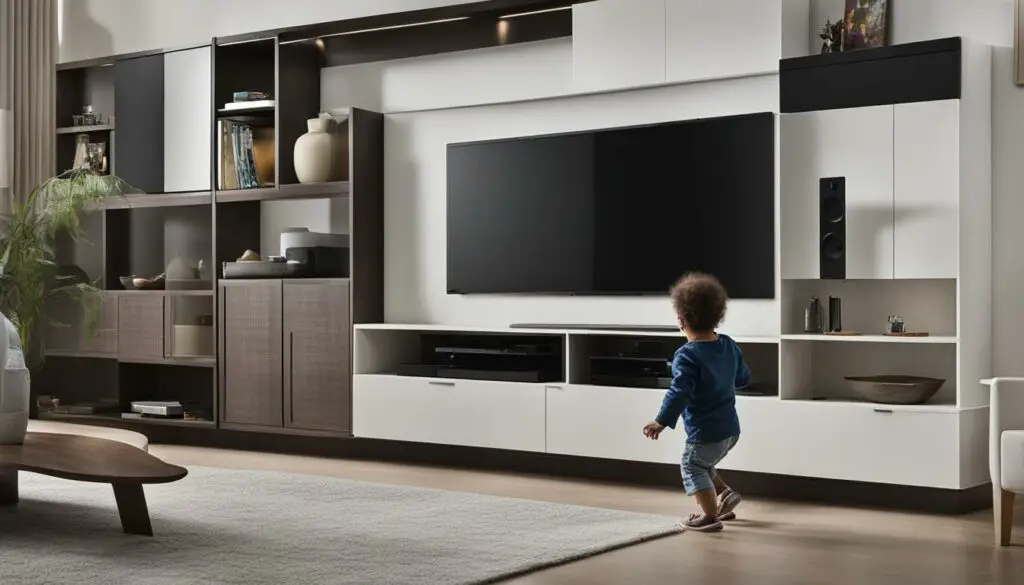As a parent, your child’s safety is your top priority. One of the potential hazards in your home includes cords that can pose a danger to babies and toddlers. By babyproofing cords, you can minimize the risk of accidents and keep your little one safe.

Key Takeaways:
- Babyproofing cords is important to protect your child from potential hazards.
- There are different types of babyproofing products available in the market specifically designed to secure cords and prevent accidents.
- By wrapping and taping cords, anchoring cords to secure furniture, and using cord covers and ties, you can keep cords out of reach and prevent tangling and strangulation.
- Additional safety tips include keeping cords out of reach, using cord shorteners, and supervising your child’s interactions with cords.
- Babyproofing outlets, appliances, window blinds, and cords on furniture and baby gear are also important measures to take.
The Dangers of Cords for Babies and Toddlers
As a parent, keeping your little one safe is your top priority. It’s important to be aware of potential hazards in your home, including cords. Cords can pose a serious danger to babies and toddlers, putting them at risk of strangulation and injury.
Babies and toddlers are naturally curious and love to explore their surroundings. Cords can easily become tangled around their necks, leading to suffocation. In addition, cords can also cause tripping hazards, which can result in falls and injuries. It’s crucial to take steps to babyproof cords in your home to prevent these accidents from happening.
There are several ways to babyproof cords in your home. From using babyproofing products to wrapping and taping cords for safety, there are plenty of options to choose from. By taking the time to properly secure cords, you can keep your child safe and give yourself peace of mind.
When using cords with babies and toddlers, it’s important to practice extra caution. Keep cords out of reach whenever possible, and use cord shorteners to prevent tangling. Supervise your child’s interactions with cords, and teach them about the dangers of playing with them.
By being aware of the dangers of cords for babies and toddlers and taking steps to babyproof them in your home, you can help ensure your child’s safety and well-being.
How to Babyproof Cords in Your Home
Babyproofing cords in your home is essential to keep your little one safe from potential hazards. Cords can pose many dangers for babies and toddlers, including strangulation and injury. But don’t worry, babyproofing cords is not as complicated as it might seem. Here are some practical tips on how to babyproof cords in your home:
- Hide cords out of reach: One of the most effective ways to babyproof cords is to hide them out of reach. This can be done by using cord covers or threading them through cord shorteners, which are easily available in the market. This ensures that cords are not dangling in areas where your baby can grab them.
- Tape cords to the floor: To prevent tripping hazards, tape cords to the floor using duct tape or cord clips. This ensures that cords are secure and not lying around where your baby can trip on them.
- Secure cords to furniture: Secure cords to furniture to prevent them from being pulled by curious little hands. Use cable ties or cord clips to fasten cords to the back or underside of furniture, such as TVs or lamps.
There are also many types of babyproofing products available specifically designed for securing cords, such as cord wraps, cord clips, and cable covers. These products can make babyproofing cords a breeze and provide peace of mind.
Using Cord Covers and Ties
Cord covers and ties can be used to hide or secure cords, minimizing the risk of tangling and strangulation. Cord covers come in different lengths and colors, making them easy to match with your home decor. Cord ties are adjustable and can be used to bundle cords together or attach them to a surface. Both cord covers and ties are affordable and easy to install.
Safety Tips for Using Cords with Babies and Toddlers
Even after babyproofing, it is important to take additional safety steps when using cords with babies and toddlers. Here are some safety tips to consider:
- Keep cords out of reach as much as possible
- Use cord shorteners to reduce the length of cords
- Never leave cords unattended or within reach of your child
- Supervise your child during playtime and restrict access to areas with cords
Babyproofing cords in your home is crucial to protect your child from potential hazards. Following these simple steps can help keep your baby safe and ensure that you have peace of mind.
Types of Babyproofing Products for Cords
As a parent or caregiver, you know how important it is to protect your little one from potential hazards around your home. One of the most common dangers for babies and toddlers are cords, which can pose a risk of strangulation and injury. Luckily, there are several babyproofing products available in the market specifically designed to secure cords and prevent accidents.
Here are some popular types of babyproofing products you can use to babyproof cords in your home:
| Product | Description |
|---|---|
| Cord Covers | These covers are designed to hide cords and protect them from being tugged or pulled by curious little hands. They come in various sizes and colors to match your home decor. |
| Cord Ties | These ties can be wrapped around cords and furniture legs to prevent tangling and tripping hazards. They can also be used to keep cords away from pets and small children. |
| Cord Shorteners | These shorteners are adjustable and can be used to keep excess cord length out of reach. They are easy to install and can be used for various types of cords, including blinds and curtains. |
| Cord Clips | These clips can be attached to surfaces to keep cords securely in place, preventing them from dangling and becoming a potential hazard. They can be used for power cords, phone cords, and more. |
Using these babyproofing products can help minimize the risk of accidents and keep your child safe from harm. Make sure to follow the instructions carefully when using them and check them regularly to make sure they are still secure.
Remember, no product can substitute for active supervision and safety measures. Always keep cords out of reach, and supervise your child’s interactions with cords and electrical appliances. By taking these precautions, you can ensure your child’s safety and enjoy peace of mind as a parent.
Using Cord Covers and Ties
Cord covers and ties can be incredibly useful tools to babyproof cords in your home. These products help hide or secure cords, minimizing the risk of tangling, tripping, and especially strangulation, which can be fatal for babies and toddlers.
When choosing cord covers, look for ones that are made specifically for the type and size of cord you need to cover. Many cord covers are self-adhesive and can easily be attached to walls and baseboards. Some cord covers are also paintable, which can help them blend in with your home décor.
Cord ties are another option for keeping cords neat and tidy. Use them to bundle cords together or to secure them to furniture or walls. Some cord ties are even adjustable, allowing you to easily change the length of the cord depending on your needs.
Always be sure to keep cords out of reach of babies and toddlers. If possible, try to keep cords behind furniture or out of sight altogether.
Using Cord Covers and Ties: A Step-by-Step Guide
Here is a step-by-step guide to using cord covers and ties to babyproof cords in your home:
- Identify the cords that need to be covered or secured.
- Choose the appropriate cord cover or tie for the job.
- Measure the length of cord you need to cover or secure.
- Install the cord cover or tie according to the manufacturer’s instructions.
- Ensure that the cord is neatly tucked away and out of reach of babies and toddlers.
Wrapping and Taping Cords for Safety
Another way to babyproof cords is by wrapping and taping them to keep them out of reach and prevent tripping hazards. Follow these simple steps:
- First, unplug the cord and make sure it is not in use.
- Next, gather the cord together and wrap it around your hand to create a neat bundle.
- Use a twist tie or a cable clip to secure the bundle together.
- Finally, use electrical tape to wrap the bundle securely, making sure to cover the entire length of the cord.
Make sure to keep the wrapped cord away from your child’s reach and sight. It’s important to note that wrapping cords can help prevent tangling and tripping hazards, but it does not entirely eliminate the risk of strangulation. Always supervise your child around cords and keep them out of reach as much as possible.
Additionally, it’s crucial to avoid wrapping cords too tightly, as this can cause them to overheat and become a fire hazard. As an alternative to wrapping cords, you can also use cord covers or ties, which are designed to hide or secure cords safely. These products come in a variety of styles and sizes, including covers that can be painted to match your walls.
By taking the time to wrap or tape cords, you can create a safe environment for your child to explore without worrying about potential dangers. Remember, your child’s safety is a top priority, and by following these safety tips, you can enjoy peace of mind knowing that your home is babyproofed.
Anhoring Cords to Secure Furniture
You may not realize it, but furniture such as TVs, lamps, and bookcases can pose a serious risk to babies and toddlers due to their cords. Children are naturally curious and may tug or pull on cords, potentially causing the furniture to topple over. It’s vital to anchor cords to secure furniture in your home to prevent these accidents from happening.
Here are some steps you can take to anchor cords and keep your little one safe:
| Step | Instructions |
|---|---|
| 1 | Identify any furniture in your home that has cords attached, such as lamps or TVs. |
| 2 | Purchase furniture anchoring kits designed to secure furniture to walls or floors. |
| 3 | Follow the instructions provided with the anchoring kit to attach the furniture to the wall or floor securely. |
| 4 | Wrap any exposed cords around cable winders or cord covers to keep them organized and out of reach of little hands. |
Always ensure that your furniture is secure before leaving your child unsupervised. There are also cord shorteners and safety wraps available that can help keep cords tidy and organized, minimizing any tripping hazards.
By anchoring cords to secure furniture, you can help prevent accidents and keep your baby safe from harm.
Safety Tips for Using Cords with Babies and Toddlers
Cords can be a potential hazard for your little ones. Here are some safety tips to keep in mind:
- Keep cords out of reach of children. Make sure they are not dangling or within grabbing distance.
- Use cord shorteners to keep them taut and prevent entanglement.
- Supervise your child’s interactions with cords and teach them not to play with them.
- Unplug cords when not in use and keep them coiled and stored away.
- Check cords regularly for fraying or damage and replace them if necessary.
By following these safety tips, you can help prevent accidents and ensure your child’s safety around cords.
Babyproofing Outlets and Appliances
Babyproofing your home isn’t just about securing cords. It’s also about protecting your little one from the dangers of outlets and appliances. Here’s what you need to know:
Babyproof Outlets
Outlet covers are an easy and inexpensive way to protect your baby from electric shock. They come in two types: plug-in and screw-in. Plug-in outlet covers are easy to install and can be used on any outlet. Screw-in outlet covers require a bit more effort to install, but they are more secure.
Remember, when babyproofing your outlets, always make sure that the covers are snug and properly installed. If your baby can still pry them loose, consider replacing them with a different type of cover.
Babyproof Appliances
Appliances can be a danger to your baby in more ways than one. Cords can be a source of strangulation, and buttons or knobs can be turned on or off by curious little fingers.
To prevent accidents, always keep cords out of reach or securely wrapped and tucked away. Consider using cord shorteners or zip ties to keep cords organized. If possible, keep appliances out of your baby’s reach, or consider using appliance locks to prevent them from being turned on or off accidentally.
Remember, the best way to protect your baby from electric shock or other accidents is to always supervise their interactions with appliances and keep them out of reach whenever possible.
Babyproofing Cords for Window Blinds
Window blinds can be a potential safety hazard for babies and toddlers when their cords are left unsecured. Cords can become tangled or create loops, which can accidentally strangle or choke your little one. It is important to babyproof cords for window blinds to keep your child safe.
Here are some tips on how to babyproof cords for window blinds:
- Shorten cords: The longer the cords, the greater the risk of accidents. Shorten cords to reduce the risk of tangling, and use cord shorteners to keep them out of reach of your child.
- Use cord stops: Cord stops can be used to prevent cords from being pulled too far and creating loops. They can also be used to hold cords together and out of reach of children.
- Install cordless blinds: Consider installing cordless blinds to eliminate the risk of cord-related accidents altogether. Cordless blinds are available in a variety of styles and sizes to fit your needs.
- Position furniture away from windows: Move furniture away from windows to prevent children from climbing up and accessing cords. This will also prevent furniture from accidentally pulling cords and blinds down.
Babyproofing cords for window blinds is an important step in ensuring the safety of your child. Remember to always supervise your child around cords and blinds, and never leave them unattended. With these tips, you can help prevent accidents and keep your child safe.
Securing Cords on Furniture and Baby Gear
When it comes to babyproofing your home, don’t forget to secure cords on furniture and baby gear to prevent accidents and entanglement. Here are some tips on how to do it:
Secure cords on furniture:
Anchor cords to secure furniture, such as TVs or lamps, to prevent them from being pulled down by curious little hands. Use zip-ties, cable covers, or cord shorteners to keep cords out of reach and prevent tripping hazards.
Secure cords on baby gear:
Make sure cords on strollers, high chairs, and car seats are securely fastened and out of reach. Use a cord wrap, zip-ties, or velcro straps to keep cords tidy and prevent entanglement.
Remember, babies and toddlers are curious and love to explore, which could lead to potential dangers. Always supervise their interactions with cords and keep cords out of reach.
By following these safety tips and babyproofing your home with the right products, you can ensure your little one stays safe and healthy.
Conclusion
Congratulations! You now have all the information you need to babyproof the cords in your home and keep your little one safe. Remember, cords can pose serious risks to babies and toddlers, so it’s essential to take measures to protect them.
You learned about the dangers of cords, including the risk of strangulation and injury. You also discovered various techniques for babyproofing cords in your home, including using cord covers and ties, wrapping and taping cords, and anchoring cords to secure furniture.
Additionally, you explored different types of babyproofing products specifically designed for securing cords, ranging from simple cord covers to full cable management systems. You now know how to use these products to keep cords out of reach and prevent tangling and tripping hazards.
Finally, we provided safety tips for using cords with babies and toddlers, such as keeping cords out of reach, using cord shorteners, and supervising your child’s interactions with cords.
Now that you have this knowledge, it’s time to take action and babyproof the cords in your home. By doing so, you can rest assured that your little one is safe and sound.




